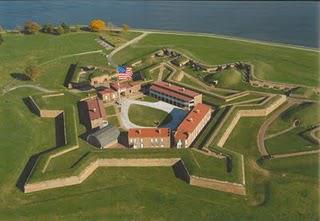
Fort McHenry
I've always loved geography and been fascinated by maps. You put an atlas or map in front of me and I'm drawn to it like iron to a magnet. I pour over maps as if there was some deep, precious secret to be found in the lines and names on the page (or increasingly, the computer screen).I'm this way with all maps, but I especially like when I can relate what I read on a map to what I've seen with my own eyes. Naturally, I'm most familiar with my hometown, Baltimore, and was just looking at a map of the city's expansive harbor. Baltimore and it's eastern suburbs boast one of the most interesting coastlines of any large American city. It's located on the fall line and straddles, surrounds really, the wide estuary that is the lower Patapsco River, just a few miles from the Chesapeake Bay. Go ahead and look at this coastline on google maps or some other online resource. The land and water reach out for one another as low-lying peninsulas entwine with wide, slow-flowing tidal rivers.
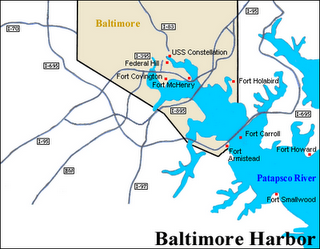
Simplified map showing the "forts" of Baltimore
Take a close look around this coastline, the harbor and Patapsco River, and you'll notice a curiosity. Around the periphery where river meets bay, smack in the middle of the shipping channel, and right at the entrance to the famous Inner Harbor, you'll read names of places with the same prefix. Fort Howard, Fort McHenry, Fort Carroll, Fort Smallwood, Fort Armistead. What are all these forts? Why does Baltimore need such protection, is the city at risk from some foreign armada?Well no, not today of course. But if you think historically, the answer is yes, but let's come back to that.
---
Joyce and Complexity in the Ordinary
James Joyce was without a shadow of a doubt a genius. He possessed uncommon insight of the human condition and perhaps unsurpassed command of the English language. His short stories and novels are favorites of this blogger and stand among the canonical writings of western literature. A great artist doesn't repeat himself in his art. Joyce was no exception, except in one aspect. He set all of his fiction in or near Dublin around the turn of the twentieth century. At that time a modest, poor city, ruled by the British. Yet Joyce knew, and was able to expertly articulate, that even little Dublin, imperial also-ran, possessed immense complexity in its myriad landmarks, winding streets, distinct districts, and the fascinating richness of a long history (with long memories).
Plot the courses of Leopold Bloom and Stephen Dedalus on a dated Dublin map, following their dual journeys during that long June day, and you'll know what I mean. Read the text and feel the life of the city, the character of the place as Joyce intended, and you'll know exactly what I mean.
Joyce's fiction helps remind us that there is richness to be gained by noticing the seemingly common around us, whether of historical Dublin or modern Baltimore.
Speaking the Ulysses, that novel begins at a martello tower in Sandycove, a kind of small fort, that guards the southern approach to Dublin Harbor and the mouth of the River Liffey, which flows nicely back to where I started.
---
Forts of Baltimore
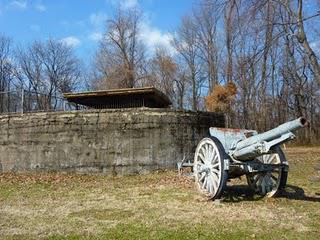
The silent canon and battlements at Fort Howard
Any ship approaching Baltimore from the sea will have to pass by the twin sentinels of Fort Howard and Fort Smallwood, a modern Scylla and Charybdis (okay, that's my last Joyce reference), which are situated on the north (Howard) and south (Smallwood) shores of the wide mouth of the Patapsco River. Sailors need have no fear however, the forts today are just parks, the guns long since removed. However, evidence of their former function remains. A visit reveals the concrete encasements where large cannon once stood. And the remnant fortifications weren't built at the time of the Revolution, but at the end of the nineteenth century, which strikes me as odd. Was there any fear at that time of an enemy fleet actually attacking Baltimore, way up the Chesapeake Bay? I hardly think so, but there the forts were built.Fort Howard has a long and interesting history. In 1814, but during the War of 1812, which we'll return to shortly, a large British expeditionary force, the same troops that had earlier invaded Washington and burned the White House, landed near Fort Howard, at North Point. The army marched up the Patapsco Neck peninsula to attack Baltimore from the east. They were temporarily halted at the Battle of North Point and forced to abandon the expedition as they met superior American forces just east of the city. They embarked at Fort Howard and sailed away to disaster at New Orleans. Fort Howard remained active and armed well into the twentieth century even as the threat of invasion receded to impossibility. A Veteran's hospital was built on part of the site. During Vietnam, it was used to train special forces, and a mock Vietnamese village, including tunnels, was built there. Today it's a pleasant park with a great view.
Sail further up the Patapsco and you'll approach the Key Bridge (named for Francis Scott Key, who we'll meet again shortly), which spans the harbor. Below the bridge you'll see a small man-made island with concrete walls in the shape of a hexagon. This is the long-since abandoned Fort Carroll. This fort was built in the middle of the nineteenth century to act as additional protection for Baltimore, perhaps with the memories of 1812 still fresh. But the fort was never really much of a defense. It took half a century to complete, more or less, was never fully gunned, or manned for very long. Thankfully it was never required to fire its cannon in anger. Today it stands as something seen but rarely visited. A habitat for wild animals and not men.
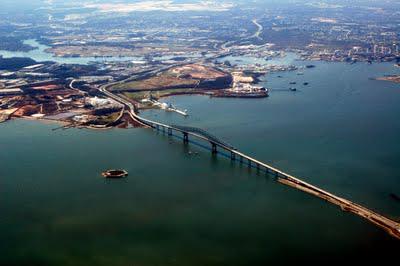
Key Bridge with Fort Carroll (mid channel) and Fort Armistead (below the bridge)
Look to your left (south), or port if you will, as you sail past Fort Carroll and you'll see Fort Armistead just below the southern end of the Key Bridge. The fort got its name from Major George Armistead who led the defense of Fort McHenry (we're getting there) during the War of 1812. The fort doesn't have a lot of history, but it is home to the Starscape Festival, which has to be Baltimore's largest overnight annual rave.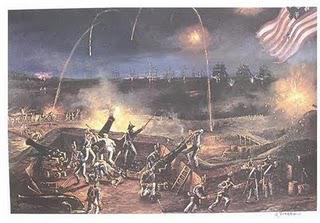
A depiction of the bombardment of Fort McHenry
Sail farther up the river and you'll run smack into one of Baltimore's most famous landmarks, Fort McHenry; you can't enter the Inner harbor without falling under its guns. Of course today those restored guns can't fire, but back in 1814 the site became famous. While the British expedition was approaching Baltimore from Fort Howard, the navy began a day long bombardment of Fort McHenry. Knock out the fort and they could have steamed into the harbor, shelled the American militia from the sea and then (it was hoped) captured the city. Well despite a lot of cannon and rocket fire, the British ships couldn't silence the fort (or even damage it). They gave up. The battle was lost.An interned American lawyer, Francis Scott Key, watched the bombardment from a British ship. He was so inspired upon seeing the American flag flying at the end of the battle that he penned a poem that would later be named the "Star Spangled Banner", and eventually become the national anthem of the United States.
---
Today the five forts are three parks, one abandoned island, and a national historic monument. But they're certainly more than just names on a map. They're a reminder that I could spend a lifetime exploring the stories of the places in this one city. What else might I discover? What fascinating facts and histories are to be revealed in your city?

